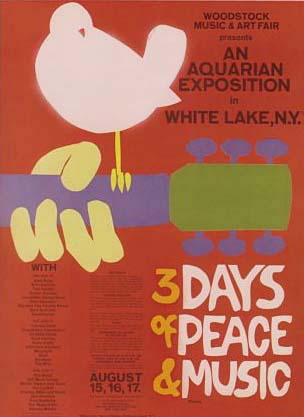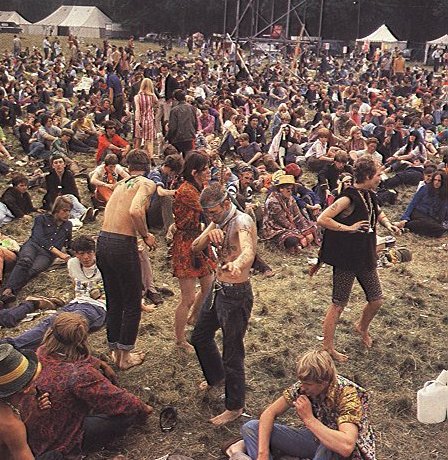WOODSTOCK
One of many popular-music festivals of the 1960s, the Woodstock Music and Arts Fair of 15-17 August 1969 began as an organized event, descended into chaos, and emerged as the most legendary rock festival in history, known simply as Woodstock.
 Woodstock at first seemed as if it would be simply another rock and roll music festival. Hoping for three days of peace and music, a group of four young businessmen decided to hold a music festival in the town of Woodstock, New York, known for its arts community. As they began planning, and as they hired more and more famous musical acts to perform, the festival grew too big and was eventually moved to a dairy farm, owned by Max Yasgur (1920–1973), near the town of Bethel, not far from Woodstock. Woodstock at first seemed as if it would be simply another rock and roll music festival. Hoping for three days of peace and music, a group of four young businessmen decided to hold a music festival in the town of Woodstock, New York, known for its arts community. As they began planning, and as they hired more and more famous musical acts to perform, the festival grew too big and was eventually moved to a dairy farm, owned by Max Yasgur (1920–1973), near the town of Bethel, not far from Woodstock.
The size of the festival proved to be a big problem. The festival attracted nearly half a million people, most in their teens and twenties. The festival organizers were not prepared for traffic jams; insufficient food, toilets, and medical care; and security and drug problems, among many others. Adding to these problems, two rainstorms drenched the audience and created a mud bath out of the farm.
The organizers did not expect 200,000 people to arrive by Friday morning. They had exactly three ticket booths in place. In a matter of minutes, the festival became a free event. Not one cent was ever collected at the gate. In fact, after noon on Friday, there was no gate.
 People parked their cars as far as 20 miles away. Once you arrived, you had to stay; there was nowhere to go. There was no place to sleep, no place to bathe, no place to eat... That weekend Bethel became the third largest city in the state. No one had planned for this. For the establishment, particularly parents, the weekend was a nightmare. Not only did the kids get along well, they shared everything including drugs, sex, sleeping and bathing facilities. People parked their cars as far as 20 miles away. Once you arrived, you had to stay; there was nowhere to go. There was no place to sleep, no place to bathe, no place to eat... That weekend Bethel became the third largest city in the state. No one had planned for this. For the establishment, particularly parents, the weekend was a nightmare. Not only did the kids get along well, they shared everything including drugs, sex, sleeping and bathing facilities.
For a while, during the rain, the sound system failed completely. However, nobody cared. The rain was present for most of the three days. The grassland turned to mud. The stage began to slide down the hill on which it was constructed; then it sagged to one side.
The gathering was nonviolent: there were no arrests for fighting. Woodstock represented the peak of "flower power," promoted by hippies who encouraged people to make love, not war.
When a music festival at Altamont, California, erupted into violence and murder a few months later, many looked back at the peaceful Woodstock festival as the last gasp of 1960s youthful idealism. Woodstock was, in many ways, a symbolic high point for the 1960s generation, proving that peace and love were possible in the world, if only for a moment.
The Stars of Woodstock
Although thunderstorms cut some performances short, those in attendance were not disappointed when they actually paid attention to what was happening on stage.
Day 1: Richie Havens, Swami Satchidananda, Country Joe McDonald, John B. Sebastian, Sweetwater, Incredible String Band, Bert Sommer, Tim Hardin, Ravi Shankar, Melanie, Arlo Guthrie, Joan Baez
Day 2:
Quill, Keef Hartley Band, Santana, Canned Heat, Mountain, Janis Joplin, Sly & The Family Stone, Grateful Dead, Creedence Clearwater Revival, The Who
Day 3: Jefferson Airplane, Joe Cocker, Country Joe & The Fish, Ten Years After, The Band, Blood Sweat And Tears, Johnny Winter, Crosby, Stills, Nash & Young, Paul Butterfield Blues Band, Sha-Na-Na, Jimi Hendrix
Some of the stars declined invitations:
- The Beatles (John Lennon said he couldn't get them together)
- Led Zeppelin (Got a higher paying gig elsewhere)
- The Doors (Jim Morrison hated large outdoor venues)
- Bob Dylan (Turned it down because of his disgust of the hippies hanging around his house)
- Jethro Tull (Turned it down because they thought it wouldn't be a big deal.)
Interesting facts:
- 60 000 people were expected
- 186 000 tickets were sold
- 500 000 people attended the festival
- A ticket for one day cost $8; a 3-day ticket: $24.
- Although there were more than a few drug busts, there were no reports of burglary or violent crime in the surrounding communities.
- The performers came and went via helicopter; it was the only way in or out.
- There were no collection bins anywhere within eyeshot of the festival site
- 2 festival births and 3 deaths
- A hit of acid or mescaline cost 4 dollars; an ounce of marijuana cost 15 dollars
- There were 18 doctors and 36 nurses who treated 6 000 patients
- On August 16, fifty more doctors were flown in from New York City
- 90% of the festival attendees smoked marijuana
- During the three days of the festival, 450 cows were unfenced
|

